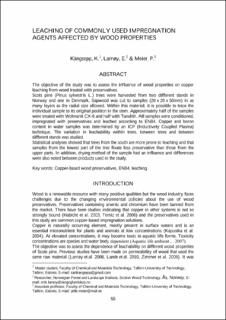| dc.description.abstract | The objective of the study was to assess the influence of wood properties on copper leaching from wood treated with preservatives. Scots pine (Pinus sylvestris L.) trees were harvested from two different stands in Norway and one in Denmark. Sapwood was cut to samples (20 x 20 x 50 mm) in as many layers as the radial size allowed. Within this material, it is possible to trace the individual sample to its original position in the stem. Approximately half of the samples were treated with Wolmanit CX-8 and half with Tanalith. All samples were conditioned, impregnated with preservatives and leached according to EN84. Copper and boron content in water samples was determined by an ICP (Inductively Coupled Plasma) technique. The variation in leachability within trees, between trees and between different stands was studied. Statistical analyses showed that trees from the south are more prone to leaching and that samples from the lowest part of the tree fixate less preservative than those from the upper parts. In addition, drying method of the sample had an influence and differences were also noted between products used in the study. | |
